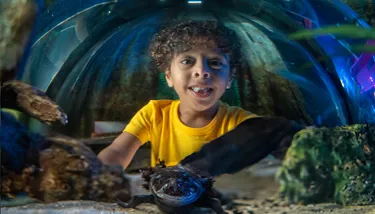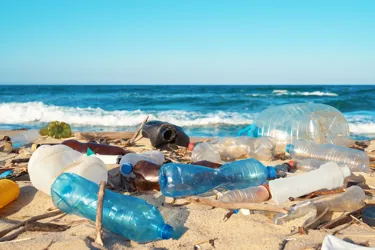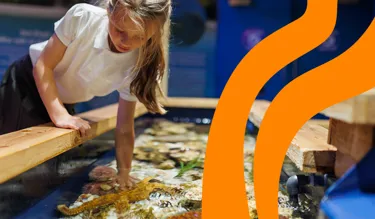Ocean Conservation: Why Little Splashers Make Big Waves
- Friday 3rd January 2025
- Laura Di Pasquale
- Conservation, Citizenship, School Trip

Picture this: a ten-year-old staring at a photo of a turtle tangled in plastic, turning to you with those big, innocent eyes and asking, “Why did grown-ups let this happen?” Stinger! Educating young people about the ocean’s troubles is no small feat, but it’s also a golden opportunity to shape a generation that won’t just simply turn a blind eye to environmental crises. Let’s dive into why teaching kids about the ocean is as important as coffee on a Monday morning and how you can potentially make it a splashy success.
Why Teach Kids About the Ocean?
The ocean is basically the superstar of natural ecosystems - powerful, awe-inspiring, and absolutely vital to keeping our planet running smoothly. It’s the unsung hero of Earth, quietly handling all the big jobs like producing oxygen, regulating the climate, and giving a home to everything from majestic whales to seriously weird-looking blobfish. But here’s the problem: it’s under constant threat. Plastic pollution, overfishing, and climate change are putting the ocean in real danger.
Here’s the twist: kids love the ocean. Whether it’s screaming after stepping on a jellyfish on holiday or being mesmerised about ocean life that glows in the dark, kids are naturally curious about marine life. The unknown depths and the concept of underwater volcanoes, trenches, and shipwrecks are like a real-life treasure hunt to them. Teaching them while they’re young can spark a passion that could grow into lifelong action. Plus, let’s be honest, they’ll probably nag the adults in their lives to be better too. Two birds, one stone!

Active Citizenship: From Curious Questions to Ocean Protectors
Active citizenship might sound like something only MPs do, but for kids, it’s all about turning empathy into action. That’s where SEA LIFE’s Friends of the Sea initiative comes in. Think of it as a superhero training camp, minus the capes (although, who am I to stop you?). This program, designed for KS2 pupils, is packed with classroom goodies like lesson plans, teaching ideas, and activities for planning an ocean party. It’s all FREE (teachers love a freebie) and designed to get kids thinking about how their choices - such as saying “no” to plastic straws - impact the world’s oceans. Small actions like these can inspire big waves of change! It’s active citizenship with a side of glitter glue. For those of you who dread the words “group project,” fear not. The Friends of the Sea Challenge Pack has ready-made activities to turn your pupils into problem solvers. From debates about tackling pollution to mini-campaigns for endangered species, these challenges are as engaging as they are educational. Plus, they’re bound to inspire at least one child to proudly announce, “I’m saving the whales!”

SEA LIFE: School Trip (Without the Drama)
Now, let’s talk about school trips. Yes, they can be logistical nightmares involving soggy sandwiches, sick bowls and a lot of “Are we there yet?” But a visit to SEA LIFE is worth every second. Imagine your pupils wide-eyed as they walk through an underwater tunnel, coming face-to-fin with a shark. Or the sheer joy of watching penguins waddle like tiny tuxedo-clad comedians. These experiences don’t just entertain - they create a genuine emotional connection to marine life. Research shows that when kids feel a bond with something, they’re more likely to want to protect it. So, while they’re marveling at jellyfish (and commenting that they look like flying ghosts), they’re also developing the empathy needed to become ocean advocates. And let’s face it, it’s a win for you too: no prep, no stress, just a brilliant day out that reinforces what they’ve learned in class.
Ocean-Friendly Teaching Ideas
Still wondering how to make ocean conservation a hit in your classroom? Here are a few ideas to make your pupils go “WOW!” (and maybe even you):
- Ocean Olympics: Create a quiz or game using teaching ideas from the Friends of the Sea resources. Bonus points if you make the kids pretend to be sea creatures.
- Trash or Treasure?: Challenge pupils to turn recycling into art. Who can build the best sea turtle from old cereal boxes and bread wrappers?
- Climate Champions: Use the challenge cards to spark debates about how small changes - like swapping cling film for beeswax wraps - can help tackle climate change and protect the oceans.
- Community Crusaders: Get them organizing a litter-pick or making posters for local shops about reducing plastic. These are the school experiences and teachers that children remember, guaranteed.

How to Get Involved
Feeling inspired? Here’s how to jump on board the ocean-saving train:
- Browse the Conservation Classroom: You’ll unlock a treasure trove of free resources for schools.
- Request the Challenge Pack: Your one-stop shop for turning your classroom into a conservation HQ.
- Plan a SEA LIFE Trip: It’s fun, educational, and involves zero marking. What’s not to love?
A Final Splash
Let’s face it: teaching about the ocean isn’t just another box to tick on the curriculum. It’s about raising kids who understand that their actions, no matter how small, can ripple out to create big changes. The Friends of the Sea program is here to make that job easier, with brilliant resources and activities that get kids thinking, feeling, and doing. So whether you’re brainstorming assemblies, downloading teacher resources, or gearing up for a SEA LIFE trip, remember: every little effort helps. Who knows? That little chatterbox in your class that is always swinging on their chair, might just grow up to save the world’s oceans, or at the very least, refuse to buy plastic straws. And that’s a pretty good start.
Related blogs

Dive into Learning: How Aquarium Trips Inspire Knowledge, Empathy, and Love for the Ocean
Planning a geography or science school trip can be a lot of work, but watching a child’s eyes light up when they enter an aquarium is a joy to behold. It’s a journey into the ocean’s mysteries, a chance to inspire empathy, and an opportunity to show students how interconnected our world truly is.
Related blog posts
How a School Aquarium Trip Can Help Students Feel Calm
It’s no secret that the wellbeing of our children has taken a hit in recent years. From pandemic disruptions to the ever insisting presence of social media, young people face a barrage of pressures previous generations could never have imagined. However, what if there was a way to make learning about wellbeing fun, engaging, and memorable? Enter the humble aquarium trip!
Related blog posts
Creative, captivating and colourful: Ocean-inspired learning for KS1&2
The world’s oceans are full of hidden depths when it comes to cross-curricular learning for KS1&2 teachers. Here are five ideas for ocean-themed projects – and how to integrate them into the classroom.
Related blog posts
Oceans at COP30 + engaging activities to dive into
For teachers, COP30 is a good way to connect global policy to the classroom, showing students that protecting the ocean isn’t just about wildlife, it’s about climate, people, and our shared future.
Related blog posts